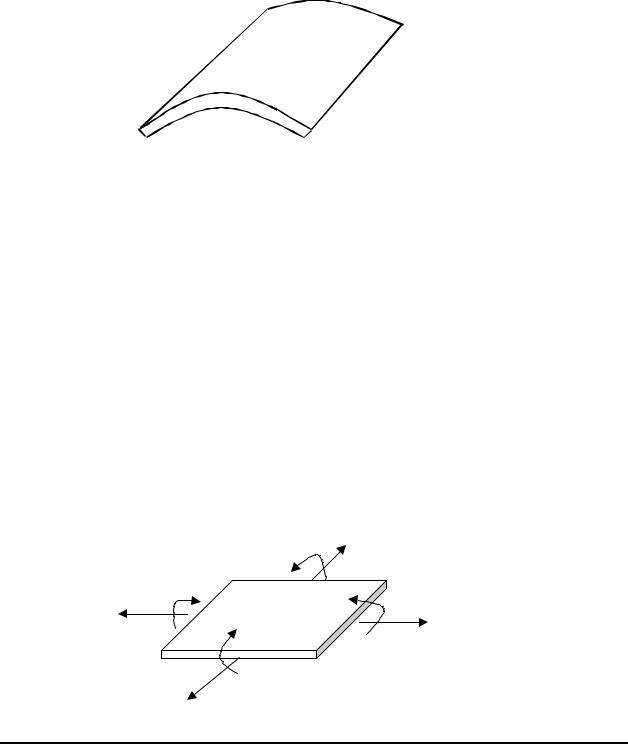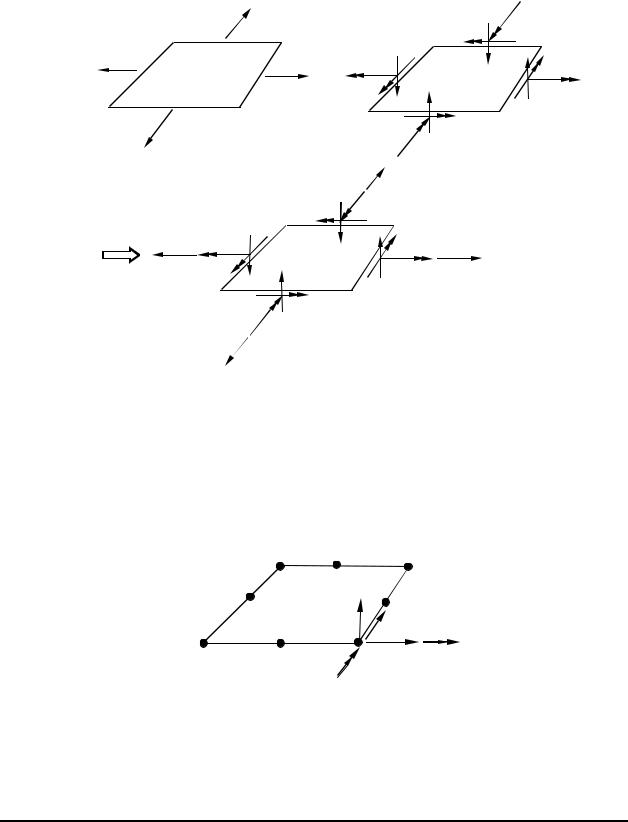
- •Copyright Notice
- •Table of Contents
- •Chapter 1. Introduction
- •I. Basic Concepts
- •Examples:
- •Why Finite Element Method?
- •Applications of FEM in Engineering
- •Examples:
- •A Brief History of the FEM
- •FEM in Structural Analysis (The Procedure)
- •Example:
- •Available Commercial FEM Software Packages
- •Objectives of This FEM Course
- •II. Review of Matrix Algebra
- •Linear System of Algebraic Equations
- •Matrix Addition and Subtraction
- •Scalar Multiplication
- •Matrix Multiplication
- •Transpose of a Matrix
- •Symmetric Matrix
- •Unit (Identity) Matrix
- •Determinant of a Matrix
- •Singular Matrix
- •Matrix Inversion
- •Examples:
- •Solution Techniques for Linear Systems of Equations
- •Positive Definite Matrix
- •Differentiation and Integration of a Matrix
- •Types of Finite Elements
- •III. Spring Element
- •One Spring Element
- •Spring System
- •Checking the Results
- •Notes About the Spring Elements
- •Example 1.1
- •Chapter 2. Bar and Beam Elements
- •I. Linear Static Analysis
- •II. Bar Element
- •Stiffness Matrix --- Direct Method
- •Stiffness Matrix --- A Formal Approach
- •Example 2.1
- •Example 2.2
- •Distributed Load
- •Bar Elements in 2-D and 3-D Space
- •2-D Case
- •Transformation
- •Stiffness Matrix in the 2-D Space
- •Element Stress
- •Example 2.3
- •Example 2.4 (Multipoint Constraint)
- •3-D Case
- •III. Beam Element
- •Simple Plane Beam Element
- •Direct Method
- •Formal Approach
- •3-D Beam Element
- •Example 2.5
- •Equivalent Nodal Loads of Distributed Transverse Load
- •Example 2.6
- •Example 2.7
- •FE Analysis of Frame Structures
- •Example 2.8
- •Chapter 3. Two-Dimensional Problems
- •I. Review of the Basic Theory
- •Plane (2-D) Problems
- •Stress-Strain-Temperature (Constitutive) Relations
- •Strain and Displacement Relations
- •Equilibrium Equations
- •Exact Elasticity Solution
- •Example 3.1
- •II. Finite Elements for 2-D Problems
- •A General Formula for the Stiffness Matrix
- •Constant Strain Triangle (CST or T3)
- •Linear Strain Triangle (LST or T6)
- •Linear Quadrilateral Element (Q4)
- •Quadratic Quadrilateral Element (Q8)
- •Example 3.2
- •Transformation of Loads
- •Stress Calculation
- •I. Symmetry
- •Types of Symmetry:
- •Examples:
- •Applications of the symmetry properties:
- •Examples:
- •Cautions:
- •II. Substructures (Superelements)
- •Physical Meaning:
- •Mathematical Meaning:
- •Advantages of Using Substructures/Superelements:
- •Disadvantages:
- •III. Equation Solving
- •Direct Methods (Gauss Elimination):
- •Iterative Methods:
- •Gauss Elimination - Example:
- •Iterative Method - Example:
- •IV. Nature of Finite Element Solutions
- •Stiffening Effect:
- •V. Numerical Error
- •VI. Convergence of FE Solutions
- •Type of Refinements:
- •Examples:
- •VII. Adaptivity (h-, p-, and hp-Methods)
- •Error Indicators:
- •Examples:
- •Chapter 5. Plate and Shell Elements
- •Applications:
- •Forces and Moments Acting on the Plate:
- •Stresses:
- •Relations Between Forces and Stresses
- •Thin Plate Theory ( Kirchhoff Plate Theory)
- •Examples:
- •Under uniform load q
- •Thick Plate Theory (Mindlin Plate Theory)
- •II. Plate Elements
- •Kirchhoff Plate Elements:
- •Mindlin Plate Elements:
- •Discrete Kirchhoff Element:
- •Test Problem:
- •Mesh
- •III. Shells and Shell Elements
- •Example: A Cylindrical Container.
- •Shell Theory:
- •Shell Elements:
- •Curved shell elements:
- •Test Cases:
- •Chapter 6. Solid Elements for 3-D Problems
- •I. 3-D Elasticity Theory
- •Stress State:
- •Strains:
- •Stress-strain relation:
- •Displacement:
- •Strain-Displacement Relation:
- •Equilibrium Equations:
- •Stress Analysis:
- •II. Finite Element Formulation
- •Displacement Field:
- •Stiffness Matrix:
- •III. Typical 3-D Solid Elements
- •Tetrahedron:
- •Hexahedron (brick):
- •Penta:
- •Element Formulation:
- •Solids of Revolution (Axisymmetric Solids)
- •Axisymmetric Elements
- •Applications
- •Chapter 7. Structural Vibration and Dynamics
- •I. Basic Equations
- •A. Single DOF System
- •B. Multiple DOF System
- •Example
- •II. Free Vibration
- •III. Damping
- •IV. Modal Equations
- •V. Frequency Response Analysis
- •VI. Transient Response Analysis
- •B. Modal Method
- •Cautions in Dynamic Analysis
- •Examples
- •Chapter 8. Thermal Analysis
- •Further Reading

Lecture Notes: Introduction to Finite Element Method |
Chapter 5. Plate and Shell Elements |
III. Shells and Shell Elements
Shells – Thin structures witch span over curved surfaces.
Example:
•Sea shell, egg shell (the wonder of the nature);
•Containers, pipes, tanks;
•Car bodies;
•Roofs, buildings (the Superdome), etc.
Forces in shells:
Membrane forces + Bending Moments
(cf. plates: bending only)
© 1997-2002 Yijun Liu, University of Cincinnati |
133 |

Lecture Notes: Introduction to Finite Element Method |
Chapter 5. Plate and Shell Elements |
Example: A Cylindrical Container.
p |
p |
internal forces:
p |
p |
|
membrane stresses dominate
Shell Theory:
•Thin shell theory
•Thick shell theory
Shell theories are the most complicated ones to formulate and analyze in mechanics (Russian’s contributions).
•Engineering ≠ Craftsmanship
•Demand strong analytical skill
© 1997-2002 Yijun Liu, University of Cincinnati |
134 |

Lecture Notes: Introduction to Finite Element Method |
Chapter 5. Plate and Shell Elements |
Shell Elements:
|
+ |
plane stress element |
plate bending element |
flat shell element
cf.: bar + simple beam element => general beam element. DOF at each node:
w |
v |
|
|
|
|
θy |
u |
θx |
|
|
Q4 or Q8 shell element.
© 1997-2002 Yijun Liu, University of Cincinnati |
135 |

Lecture Notes: Introduction to Finite Element Method |
Chapter 5. Plate and Shell Elements |
Curved shell elements:
i |
w |
θz |
|
v |
|
||
|
|
||
|
|
|
|
|
i |
u |
θx |
|
θy |
|
|
•Based on shell theories;
•Most general shell elements (flat shell and plate elements are subsets);
•Complicated in formulation.
© 1997-2002 Yijun Liu, University of Cincinnati |
136 |
